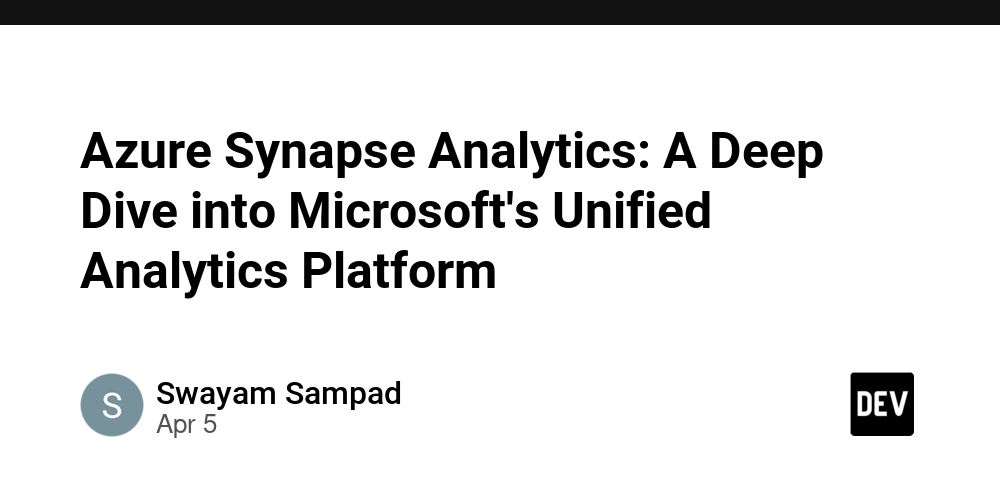Azure Synapse Analytics: A Deep Dive into Microsoft's Unified Analytics Platform
Azure Synapse Analytics: A Deep Dive into Microsoft's Unified Analytics Platform In today's data-driven world, organizations need powerful and scalable analytics solutions to extract valuable insights from their data. Azure Synapse Analytics is Microsoft's answer to this need – a fully managed, limitless analytics service that brings together data warehousing and big data analytics into a single platform. What is Azure Synapse Analytics? Azure Synapse Analytics is a unified platform that allows you to ingest, prepare, manage, and serve data for immediate business intelligence (BI) and machine learning (ML) needs. It provides a comprehensive suite of tools and services designed to handle diverse data workloads, from traditional data warehousing to complex big data processing. Key Components and Features: Dedicated SQL Pool (Data Warehousing): Provides a massively parallel processing (MPP) architecture for high-performance data warehousing. It allows you to store and analyze structured data using SQL. Offers predictable performance and cost for demanding workloads. Serverless SQL Pool (Data Lake Analytics): Enables you to query data directly in your Azure Data Lake Storage using SQL, without the need for data loading or infrastructure management. Pay-per-query model makes it ideal for ad-hoc analysis and data exploration. Supports various file formats like Parquet, CSV, and JSON. Apache Spark Pool (Big Data Analytics): Integrates Apache Spark, a powerful open-source distributed processing engine, for big data analytics. It allows you to perform data engineering, data preparation, and machine learning using languages like Python, Scala, Java, and .NET. Synapse Data Explorer: A fast and scalable data exploration service, designed for ingesting and analyzing high-volume, high-velocity data from sources like IoT devices, applications, and websites. It uses the Kusto Query Language (KQL), optimized for time-series data analysis. Synapse Studio: A unified workspace for data engineers, data scientists, and business analysts. It provides a single interface for managing all aspects of Synapse Analytics, including data integration, data exploration, data warehousing, and big data analytics. Includes code authoring, debugging, monitoring and security capabilities. Data Integration (Pipelines): Synapse Pipelines provide a fully managed cloud ETL service for data integration. You can create complex data pipelines to move and transform data from various sources to Synapse Analytics and other Azure services, leveraging over 100 built-in connectors. Security: Synapse Analytics provides robust security features, including data encryption at rest and in transit, access control, and threat detection. It integrates with Azure Active Directory for identity management. Integration with Azure Ecosystem: Seamlessly integrates with other Azure services, such as Azure Data Lake Storage, Azure Data Factory, Azure Machine Learning, and Power BI. Benefits of Using Azure Synapse Analytics: Unified Platform: Eliminates the need for separate data warehousing and big data analytics solutions, simplifying data management and reducing costs. Scalability: Provides virtually limitless scalability to handle growing data volumes and increasing user demands. Performance: Delivers high-performance analytics with MPP architecture and optimized query engines. Cost-Effectiveness: Offers various pricing models, including pay-as-you-go options, to optimize costs. Ease of Use: Simplifies data management and analytics with a unified workspace and intuitive tools. Security: Provides comprehensive security features to protect sensitive data. Use Cases: Data Warehousing: Building and managing a traditional data warehouse for business intelligence and reporting. Big Data Analytics: Processing and analyzing large datasets from various sources, such as social media, IoT devices, and web logs. Real-Time Analytics: Analyzing streaming data in real-time to identify trends and patterns. Data Exploration: Exploring and discovering new insights from data using ad-hoc queries and interactive visualizations. Machine Learning: Training and deploying machine learning models using big data. Getting Started with Azure Synapse Analytics: Create an Azure Subscription: If you don't already have one, create a free Azure subscription. Create a Synapse Workspace: In the Azure portal, create a new Synapse Workspace. Configure Storage Account: Create or use an existing Azure Data Lake Storage Gen2 account for storing data. Create SQL Pools and Spark Pools: Provision dedicated SQL pools, serverless SQL pools, and Apache Spark pools based on your needs. Start Exploring and Analyzing Data: Use Synapse Studio to connect to data sources, build data pipelines, run queries, and create visualizations. Conclusion: Azure Synapse Analytics is a powerful and

Azure Synapse Analytics: A Deep Dive into Microsoft's Unified Analytics Platform
In today's data-driven world, organizations need powerful and scalable analytics solutions to extract valuable insights from their data. Azure Synapse Analytics is Microsoft's answer to this need – a fully managed, limitless analytics service that brings together data warehousing and big data analytics into a single platform.
What is Azure Synapse Analytics?
Azure Synapse Analytics is a unified platform that allows you to ingest, prepare, manage, and serve data for immediate business intelligence (BI) and machine learning (ML) needs. It provides a comprehensive suite of tools and services designed to handle diverse data workloads, from traditional data warehousing to complex big data processing.
Key Components and Features:
- Dedicated SQL Pool (Data Warehousing): Provides a massively parallel processing (MPP) architecture for high-performance data warehousing. It allows you to store and analyze structured data using SQL. Offers predictable performance and cost for demanding workloads.
- Serverless SQL Pool (Data Lake Analytics): Enables you to query data directly in your Azure Data Lake Storage using SQL, without the need for data loading or infrastructure management. Pay-per-query model makes it ideal for ad-hoc analysis and data exploration. Supports various file formats like Parquet, CSV, and JSON.
- Apache Spark Pool (Big Data Analytics): Integrates Apache Spark, a powerful open-source distributed processing engine, for big data analytics. It allows you to perform data engineering, data preparation, and machine learning using languages like Python, Scala, Java, and .NET.
- Synapse Data Explorer: A fast and scalable data exploration service, designed for ingesting and analyzing high-volume, high-velocity data from sources like IoT devices, applications, and websites. It uses the Kusto Query Language (KQL), optimized for time-series data analysis.
- Synapse Studio: A unified workspace for data engineers, data scientists, and business analysts. It provides a single interface for managing all aspects of Synapse Analytics, including data integration, data exploration, data warehousing, and big data analytics. Includes code authoring, debugging, monitoring and security capabilities.
- Data Integration (Pipelines): Synapse Pipelines provide a fully managed cloud ETL service for data integration. You can create complex data pipelines to move and transform data from various sources to Synapse Analytics and other Azure services, leveraging over 100 built-in connectors.
- Security: Synapse Analytics provides robust security features, including data encryption at rest and in transit, access control, and threat detection. It integrates with Azure Active Directory for identity management.
- Integration with Azure Ecosystem: Seamlessly integrates with other Azure services, such as Azure Data Lake Storage, Azure Data Factory, Azure Machine Learning, and Power BI.
Benefits of Using Azure Synapse Analytics:
- Unified Platform: Eliminates the need for separate data warehousing and big data analytics solutions, simplifying data management and reducing costs.
- Scalability: Provides virtually limitless scalability to handle growing data volumes and increasing user demands.
- Performance: Delivers high-performance analytics with MPP architecture and optimized query engines.
- Cost-Effectiveness: Offers various pricing models, including pay-as-you-go options, to optimize costs.
- Ease of Use: Simplifies data management and analytics with a unified workspace and intuitive tools.
- Security: Provides comprehensive security features to protect sensitive data.
Use Cases:
- Data Warehousing: Building and managing a traditional data warehouse for business intelligence and reporting.
- Big Data Analytics: Processing and analyzing large datasets from various sources, such as social media, IoT devices, and web logs.
- Real-Time Analytics: Analyzing streaming data in real-time to identify trends and patterns.
- Data Exploration: Exploring and discovering new insights from data using ad-hoc queries and interactive visualizations.
- Machine Learning: Training and deploying machine learning models using big data.
Getting Started with Azure Synapse Analytics:
- Create an Azure Subscription: If you don't already have one, create a free Azure subscription.
- Create a Synapse Workspace: In the Azure portal, create a new Synapse Workspace.
- Configure Storage Account: Create or use an existing Azure Data Lake Storage Gen2 account for storing data.
- Create SQL Pools and Spark Pools: Provision dedicated SQL pools, serverless SQL pools, and Apache Spark pools based on your needs.
- Start Exploring and Analyzing Data: Use Synapse Studio to connect to data sources, build data pipelines, run queries, and create visualizations.
Conclusion:
Azure Synapse Analytics is a powerful and versatile platform that offers a comprehensive solution for data warehousing and big data analytics. Its unified architecture, scalability, performance, and ease of use make it an ideal choice for organizations of all sizes looking to unlock the value of their data.











































































